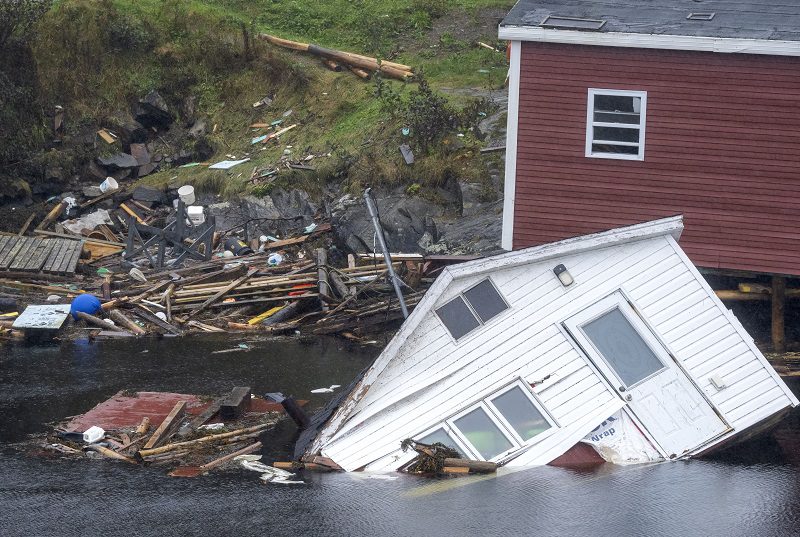Fiona officially the costliest extreme weather event in Atlantic Canada

Hurricane Fiona is the costliest extreme weather event ever recorded in Atlantic Canada, at $660 million in insured damage, according to preliminary estimates from Catastrophe Indices and Quantification Inc. (CatIQ).
The long-lived and powerful storm on Sept. 24 is also the tenth-largest in Canada in terms of insured damages, surpassing the 2011 Slave Lake, Alta. wildfire.
Insurance Bureau of Canada (IBC) released the damage estimates from CatIQ Wednesday.
Although Fiona affected all of the Atlantic provinces and Quebec, Nova Scotia and Prince Edward Island took the brunt of the insured loss, according to CatIQ.
“Although the estimated $660 million in insured damage is a record-breaking figure, many affected residents were located in high-risk flood areas and floodplains where residential flood insurance coverage is not available,” IBC said in the release. “As a result, the overwhelming majority of costs for this disaster will be borne by government.”
Nova Scotia saw more than $385 million in insured damages. Damage to trees was widespread, with numerous large trees falling on cars and buildings in Halifax. Cape Breton Island and Pictou County saw significant damage, including extensive flooding, roofs torn off buildings, roads washed out and storm surge. On the day the post-tropical storm made landfall, power outages affected more than 415,000 customers, leaving about 80% of the province without power.
In P.E.I., damage was reported across the entirety of the island. Houses were moved off their foundations by storm surge and wind tore roofs off buildings. Trees and power lines were damaged or snapped/uprooted across the island, leaving 82,000 customers without power by Sunday, Sept. 25. “This accounts for 95% of total customers on the island,” IBC said. Significant beach erosion also impacted much of the north coast.”
Canada: Top 10 Natural Disasters for Insurance Payouts (CNW Group/Insurance Bureau of Canada)
Although media reports and images from Newfoundland and Labrador showed extreme damage of homes being swept into the sea and record-breaking storm surge, insured damage amounted only to just over $7 million. Industry sources told Canadian Underwriter it’s likely there will be fairly high number of properties in Newfoundland and Labrador, Nova Scotia and P.E.I. that don’t have insurance.
Southwestern Newfoundland was particularly hard-hit by Fiona, with severe damage reported from Burgeo to Port Aux Basques. At least 20 homes were washed into the ocean, primarily in Port aux Basques, leading to the evacuation of nearly 200 people. IBC reported one fatality was confirmed in the town after a home collapsed into the sea amid intense wave action and storm surge. Homes were also destroyed in Burgeo, Burnt Islands and Fox Roost, where multiple buildings were destroyed by waves and storm surge.
New Brunswick was spared much of the damage caused by Fiona due to the easterly track of the storm, but it still saw more than $30 million in insured damage. Widespread outages occurred in Saint John, Fredericton, Moncton and the Acadian Peninsula. Damage to structures was largely located along the Northumberland Strait and near the Nova Scotia border, with large downed trees and branches, IBC said.
In Quebec, insured damages were more than $11 million. The Iles-de-la-Madeleine saw extensive flooding, with many homes and businesses flooded to a depth of several feet. Storm-surge-related flooding and erosion from large waves were reported along parts of the Gaspé Peninsula coast.
“As we begin to see the extent of damages caused by Hurricane Fiona, it is clear that much more needs to be done to enhance our resilience to extreme weather events and build a culture of preparedness moving forward,” said Amanda Dean, vice president of IBC’s Atlantic region. “Climate change is real, and the fatalities, emotional turmoil and financial consequences we’ve witnessed must be a call to action – we must prioritize the protection of all Canadians from the impacts of climate change.”
Insurance claims from severe weather have more than quadrupled across Canada since 2008, and eight of the costliest disasters in Canadian history have happened since 2013.
For the third year in a row, insured Cat losses have exceeded $2 billion annually.
Feature image: Buildings sit in the water along the shore following hurricane Fiona in Rose Blanche-Harbour Le Cou, Newfoundland on Tuesday September 27, 2022. Fiona left a trail of destruction across much of Atlantic Canada, stretching from Nova Scotia’s eastern mainland to Cape Breton, Prince Edward Island and southwestern Newfoundland. THE CANADIAN PRESS/Frank Gunn



